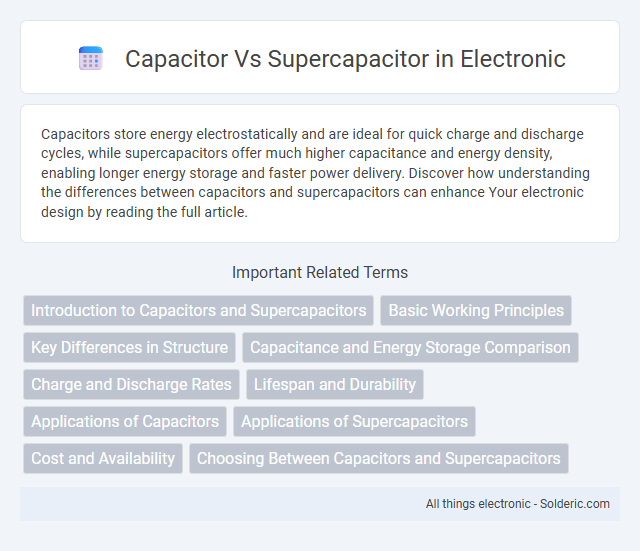Capacitors store energy electrostatically and are ideal for quick charge and discharge cycles, while supercapacitors offer much higher capacitance and energy density, enabling longer energy storage and faster power delivery. Discover how understanding the differences between capacitors and supercapacitors can enhance Your electronic design by reading the full article.
Comparison Table
| Feature | Capacitor | Supercapacitor |
|---|---|---|
| Energy Storage | Low energy density | High energy density |
| Capacitance | Microfarads (uF) to millifarads (mF) | Farads (F) to kiloFarads (kF) |
| Charging Time | Milliseconds to seconds | Seconds to minutes |
| Voltage Rating | Typically 1-100 V | Typically 2.3-2.7 V per cell |
| Applications | Filtering, signal processing, tuning circuits | Energy backup, regenerative braking, load leveling |
| Lifespan | Up to 1 million cycles | Up to 1 million cycles or more |
| Size | Small and compact | Larger due to higher capacitance |
| Cost | Low cost | Higher cost |
Introduction to Capacitors and Supercapacitors
Capacitors are electronic components that store energy electrostatically and release it quickly, commonly used in circuits for filtering, buffering, and energy storage. Supercapacitors, also known as ultracapacitors, offer much higher capacitance than traditional capacitors by utilizing electrochemical double-layer and pseudocapacitance mechanisms, enabling rapid charge and discharge cycles with greater energy density. Understanding the differences between capacitors and supercapacitors is essential for optimizing your electronic design, especially in applications requiring high power and fast energy delivery.
Basic Working Principles
Capacitors store energy electrostatically by accumulating opposite charges on two conductive plates separated by a dielectric material, enabling rapid charge and discharge cycles with limited energy density. Supercapacitors, or ultracapacitors, utilize electrochemical double-layer capacitance and pseudocapacitance mechanisms to achieve higher energy storage by storing charge at the electrode-electrolyte interface through ion adsorption and fast surface redox reactions. While traditional capacitors excel in power density and frequency response, supercapacitors bridge the gap between capacitors and batteries, offering higher energy capacity with moderate power delivery.
Key Differences in Structure
Capacitors consist of two conductive plates separated by a dielectric material, enabling energy storage through electrostatic charge. Supercapacitors feature porous carbon electrodes and an electrolyte, which increase surface area and allow energy storage via electrochemical double-layer capacitance. This structural difference results in supercapacitors having significantly higher capacitance and faster charge-discharge cycles than traditional capacitors.
Capacitance and Energy Storage Comparison
Capacitors typically offer capacitance values ranging from picofarads to microfarads, enabling quick charge and discharge cycles but limited energy storage capacity, usually in the millijoule range. Supercapacitors provide capacitance in the farad range, significantly higher than conventional capacitors, allowing them to store energy in the order of watt-hours, which bridges the gap between capacitors and batteries. The enhanced energy storage capabilities of supercapacitors arise from their electric double-layer and pseudocapacitance mechanisms, making them ideal for applications requiring rapid energy delivery and high cycle life.
Charge and Discharge Rates
Capacitors typically offer rapid charge and discharge rates, making them ideal for applications requiring quick bursts of energy. Supercapacitors excel in delivering even faster charge and discharge cycles with significantly higher power density, ensuring efficient energy transfer over numerous cycles without degradation. Your choice between the two depends on whether your application prioritizes speed or energy storage capacity.
Lifespan and Durability
Supercapacitors offer significantly longer lifespans than traditional capacitors, often exceeding one million charge-discharge cycles compared to thousands for capacitors. Your choice will benefit from their superior durability under frequent cycling and high current demands, making supercapacitors ideal for applications requiring extended operational life. Capacitors typically degrade faster due to electrolyte evaporation and dielectric breakdown, limiting their usage in high-stress environments.
Applications of Capacitors
Capacitors are widely used in electronic circuits for energy storage, filtering, and signal coupling due to their ability to store and release electrical energy rapidly. Common applications include power supply smoothing, timing circuits, and voltage regulation in consumer electronics, automotive systems, and industrial machinery. Their versatility in handling high-frequency signals makes them essential components in radio frequency (RF) communication and audio equipment.
Applications of Supercapacitors
Supercapacitors excel in applications requiring rapid charge and discharge cycles, such as regenerative braking systems in electric vehicles and grid frequency regulation. Their high power density and long cycle life make them ideal for backup power supplies, uninterruptible power systems (UPS), and portable electronics. You can rely on supercapacitors for energy storage solutions where quick bursts of energy are essential, improving overall efficiency and durability.
Cost and Availability
Capacitors generally have lower costs and are widely available due to their long-standing use in various electronic applications, making them accessible for most standard circuit designs. Supercapacitors, while more expensive, are increasingly available as demand grows for energy storage solutions with higher capacitance and rapid charge-discharge cycles. Your choice may depend on budget constraints and the specific energy storage requirements of your project.
Choosing Between Capacitors and Supercapacitors
Choosing between capacitors and supercapacitors depends on energy storage needs and application requirements; capacitors offer high-frequency response and rapid charge/discharge cycles suitable for filtering and pulse power applications. Supercapacitors excel in high capacitance and energy density, enabling longer energy release and extending battery life in backup power systems and regenerative braking. Consider voltage ratings, lifecycle durability, and power density when selecting the optimal energy storage device for electronics or automotive use.
Capacitor vs Supercapacitor Infographic

 solderic.com
solderic.com